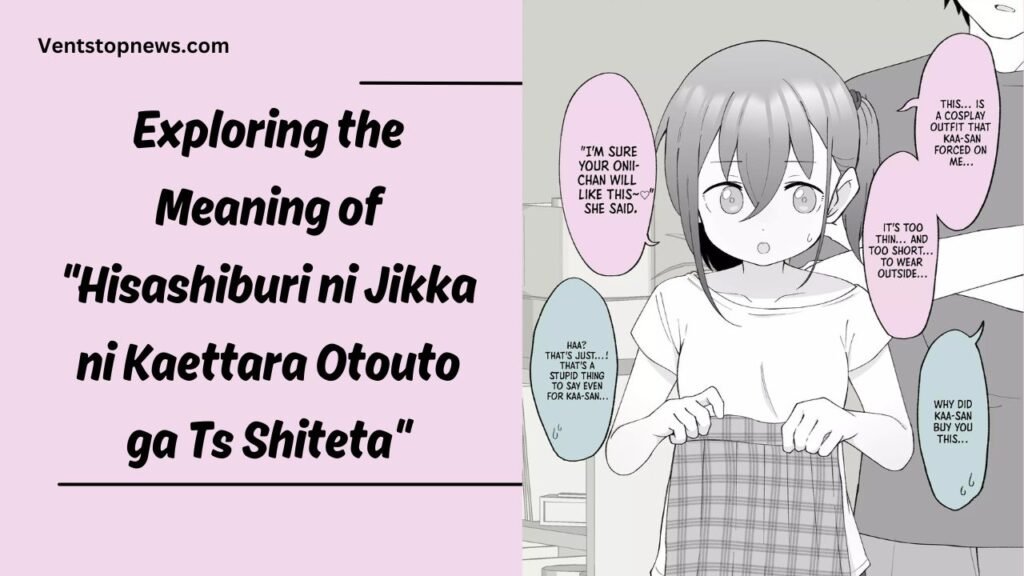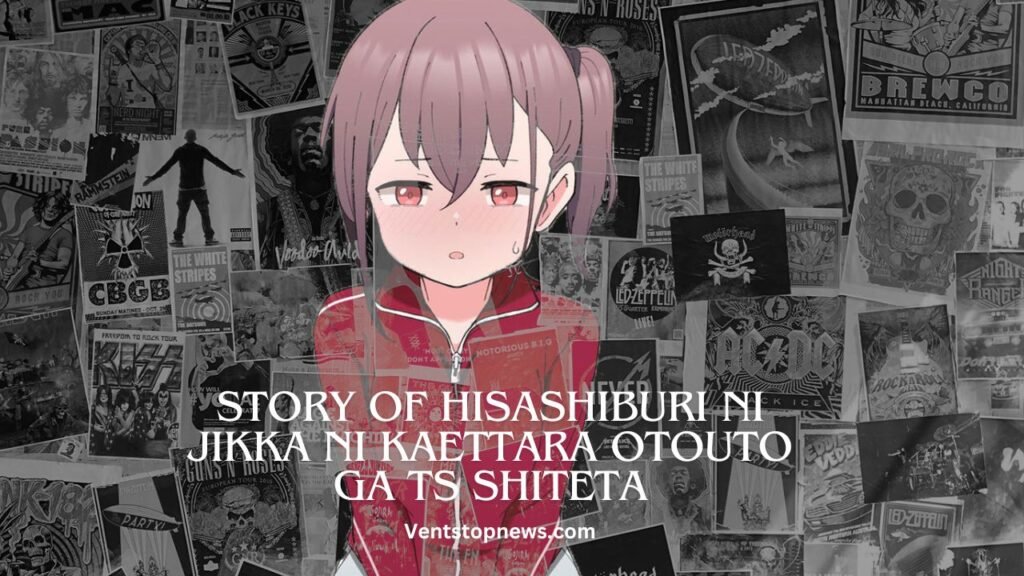
komik hisashiburi ni jikka ni kaettara otouto ga ts shiteta
Introduction:
Manga, with its captivating stories and beautiful visuals, has long been revered as a treasure trove of storytelling in Japanese literature. Among its diverse services, “komik hisashiburi ni jikka ni kaettara otouto ga ts shiteta” prides itself as a multifaceted gem that presents readers with a deep exploration of their own family bonds and personal transformation. In this creation, we will embark on an adventure to unravel the complexities of this outstanding manga, delving into its themes, characters, and cultural importance.
Embracing the Intricacies of Family Bonds:
At the coronary heart of “komik hisashiburi ni jikka ni kaettara otouto ga ts shiteta” lies a poignant exploration of family bonds. Through the lens of sibling relationships, the manga delves deep into the complexities of love, competition, and forgiveness. It invites readers to navigate the intricacies in their circle of relatives ties, from the joys of reunion to the difficult situations of reconciliation. As readers journey alongside the characters, they need to confront the conventional truths of their family dynamics that resonate across cultures and generations.
The manga’s portrayal of sibling dynamics is nuanced and relatable, shooting the essence of own family relationships with authenticity and depth. Through moments of laughter, tears and mirror images, readers are drawn into the intimate global of the protagonist and his brother and experience their joys and struggles firsthand. In this exploration of family bonds, “komik hisashiburi ni jikka ni kaettara otouto ga ts shiteta” celebrates the enduring power of love and forgiveness and reminds us of the profound impact of our connections with those closest to us.
Personal Transformation in Manga:
Besides exploring one’s own family bonds, “komik hisashiburi ni jikka ni kaettara otouto ga ts shiteta” delves into the theme of private transformation. Through the protagonist’s journey of self-discovery, readers are invited to mirror their own journeys of growth and change. From confronting beyond faults to embracing a newfound identity, the manga navigates the complexities of personal improvement with sensitivity and insight.
Through rich individual enhancement and compelling storytelling, “komik hisashiburi ni jikka ni kaettara otouto ga ts shiteta” offers readers a window into the transformative power of self-mirror image and attraction. It reminds us that growth is regularly observed by way of tough conditions and setbacks, however ultimately ends in extra knowledge and success. As readers watch the protagonist broaden, they’re stimulated to embark on their private trips of self-discovery, taking gain of possibilities for exchange and renewal.
Exploring the Meaning of “komik hisashiburi ni jikka ni kaettara otouto ga ts shiteta”:

In the rich tapestry of Japanese language and lifestyle, expressions often bring layers of meaning and evoke deep emotions. “komik hisashiburi ni jikka ni kaettara otouto ga ts shiteta” is one such phrase that sums up the essence of reunion and the passing of time. Let’s dive into the intricacies of this word and its importance in the context of the story.
Deciphering a Japanese phrase:
“Hisashiburi” translates to “long time no see”, conveying the feeling of reconnecting with someone after a long absence. It is a word imbued with nostalgia and heat, evoking memories of shared experiences and the joy of reunion.
“Jikka ni kaettara” is interpreted as “after I returned home”, suggesting an extended event or milestone in the protagonist’s existence. It shows the return to familiar surroundings and the resumption of daily life after a long absence.
“Otouto ga Ts Shiteta” is a catchphrase that adds intrigue and thriller to the story. “Otouto” is closer to “younger brother” while “Ts Shiteta” is extra ambiguous, leaving the reader wondering what exactly the younger brother did or experienced at some point in the protagonist’s absence.
Meaning in the context of the story:

In “komik hisashiburi ni jikka ni kaettara otouto ga ts shiteta”, this word catalyzes the protagonist’s journey of rediscovery and reconciliation. The protagonist returns to the household after a long absence but is met with sudden revelations and challenging situations.
The phrase “Hisashiburi ni Jikka ni Kaettara Otouto ga Ts Shiteta” sums up the central themes of the story: reunion, reflection and transformation. It emphasizes the passage of time and the changes that occur within family relationships, as well as the importance of verbal exchange and forgiveness.
Navigating the complexity of sibling dynamics:
Sibling relationships are the most complicated and varied bonds in human enjoyment, characterized by a delicate balance of rivalry, affection, and forgiveness. In “komik hisashiburi ni jikka ni kaettara otouto ga ts shiteta,” these dynamics are explored with depth and nuance, giving readers deep insight into the intricacies of brotherhood.
Unraveling the Layers of Rivalry:
Sibling rivalry is a common phenomenon that regularly stems from prioritizing interest, validation, or popularity. In the manga, the main character and his younger brother are depicted navigating challenging situations of sibling rivalry, from arguments in early life to more extensive conflicts in adulthood. Their conflict manifests itself in different approaches, from competing for parental approval to competing for the success of their endeavors. Through moments of angst and confrontation, the manga delves into the complexities of sibling rivalry and highlights approaches each could take to create a wedge between brothers and foster growth and resilience.
Exploring Affection Amidst Conflict:
Beneath the floor of rivalry lies a deep love between siblings, solid through shared reviews and unconditional love. Despite their differences and conflicts, the protagonist and his younger brother share a bond that goes beyond mere rivalry. Through moments of tenderness and vulnerability, the manga explores the intensity of their affection for each other, depicting moments of harmony and help amid the chaos of their dating. It is in these moments of connection that the true strength of their bond is revealed, reminding readers of the long-lasting electricity of family love.
The Path to Forgiveness:
At the coronary heart of “komik hisashiburi ni jikka ni kaettara otouto ga ts shiteta” lies the subject matter of forgiveness, as the protagonist grapples with past conflicts and resentments in his dating with his younger brother. Forgiveness is a relevant subject matter in sibling dynamics, supplying the possibility of recovery and reconciliation amidst the turmoil of familial struggle. Through moments of reflection and introspection, the protagonist embarks on a journey towards forgiveness, confronting his role in perpetuating struggle and in search of redemption for past transgressions. As the manga unfolds, forgiveness emerges as a transformative force, permitting the protagonist and his more youthful brother to mend their fractured relationship and flow ahead with newfound know-how and empathy.
The Visual Language of Komik:

In “komik hisashiburi ni jikka ni kaettara otouto ga ts shiteta,” the artwork plays a vital role in shaping the narrative, adding layers of intensity and emotional resonance to the narrative experience. Through problematic information, expressive characters, and evocative imagery, the visible language of manga enriches the reader’s expertise of the story and deepens their emotional involvement with the characters and issues.
Capturing emotions through strong characters:
One of the most powerful factors of the visible language of manga is its ability to capture the nuances of human emotion through character expressions and body language. From diffuse shifts in facial expressions to dramatic gestures, the artwork deliver the characters’ lifestyles into bright elements, allowing readers to empathize with their joys, sorrows, and struggles. Whether it’s the protagonist’s furrowed brow as he confronts his beyond, or his more youthful brother’s mild smile as they reconcile, each emotion is portrayed with precision and authenticity, heightening the reader’s connection to the tale.
Symbolism and visual metaphor:
In addition, manga paintings perform a key function in organizing the temper and putting the narrative through the depiction of place and composition. From the quiet splendor of the Japanese geographical region to the bustling metropolis streets, every area is rendered with care and interest in detail, immersing the reader in a worldwide story.
Humor and Reflection:
Finding the Fine Balance Between Lightness and Poignancy in Narrative
In “komik hisashiburi ni jikka ni kaettara otouto ga ts shiteta,” humor serves as a vital vehicle for both levity and introspection. Through thoughtful composition and framing, the pictures interact with the reader’s eye, developing an revel in of rhythm and pacing that enhances the narrative. Whether it’s a breathtaking shot that captures the vastness of the protagonist’s journey, or a close to-up of a person’s face that conveys their internal turmoil, every panel is cautiously crafted to rouse a positive mood and emotion, adding depth and value to the narrative.
Thought Provoking and Controversy:
Tackling Complex Themes and Manga’s Social Commentary
“Hisashiburi ni Jikka ni Kaettara Otouto ga Ts Shiteta” no longer holds back from tackling complicated topics and social issues, provoking thought and controversy in its readers. From exploring the intricacies of sibling dynamics to confronting societal expectations and cultural norms, the manga dives head-on into a wide range of themes with intensity and nuance. His exploration of taboo topics, along with incestuous relationships and intellectual challenges, invites readers to confront uncomfortable truths and question long-held ideals. By dealing directly with these complex topics, manga provokes thought and encourages meaningful talk, making it difficult for readers to follow their own perspectives and biases.
Impact on readers and society:
Exploring the Lasting Impressions and Discussions Generated Through “Hisashiburi ni Jikka ni Kaettara Otouto ga Ts Shiteta”
“Hisashiburi ni Jikka ni Kaettara Otouto ga Ts Shiteta” has left a lasting impact on readers and society, sparking discussions and debates that extend beyond its pages. His exploration of family relationships, personal growth, and societal norms resonated with readers of every age, inspiring introspection and mirrored image. Through its conceptual storytelling and compelling characters, the manga has sparked conversations approximately the character of own family, the significance of forgiveness, and the complexity of human relationships. Its impact on readers and society serves as a testament to storytelling’s enduring electricity to initiate notion, evoke emotion, and encourage trade.
Conclusion:
Ultimately, “Hisashiburi ni Jikka ni Kaettara Otouto ga Ts Shiteta” stands as a testament to manga’s long-standing legacy and cultural significance. Through its exploration of family ties, personal boom, and societal norms, the manga invites readers on a journey of introspection and discovery that resonates long after the last page is turned. His delicate balance of humor and poignancy, terrifying subjects and compelling narratives have left an indelible mark on readers and society, fueling debate and stimulating business. As we discuss the enduring legacy and cultural significance of manga, we are reminded of the transformative power of storytelling to connect, encourage and improve our lives.






